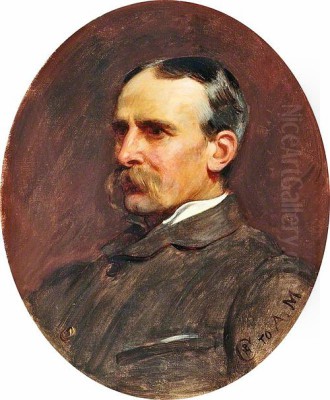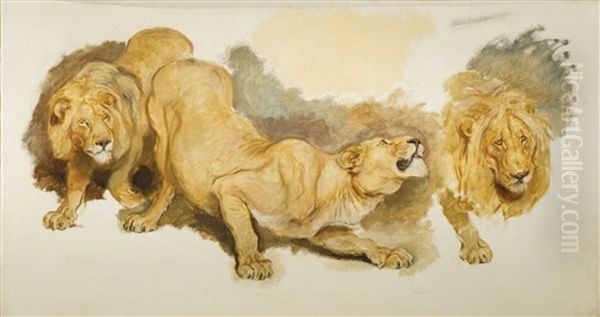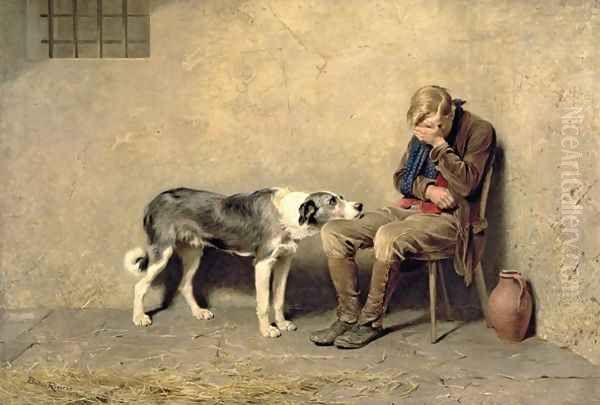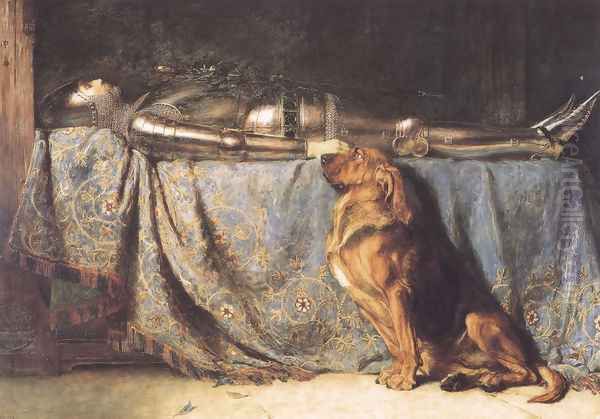
Briton Riviere stands as a significant figure in British art history, particularly renowned for his evocative paintings of animals during the Victorian era. Born in London, England, on August 14, 1840, he passed away on April 20, 1920. Riviere hailed from a family with Huguenot ancestry, a background that perhaps subtly influenced the meticulous nature often observed in his work. His artistic journey was deeply shaped by his family environment and the academic institutions he attended, leading him to become one of the most popular painters of his time, especially admired for his ability to capture the character and emotion of animals.
Early Life and Artistic Foundations
Briton Riviere's immersion in the art world began at a very young age, largely thanks to his father, William Riviere (1806-1876). William was himself an accomplished artist and a respected art educator, holding positions as a drawing master at Cheltenham College and later as an art teacher at the University of Oxford. This paternal influence was profound, providing Briton with early training and fostering his innate artistic talents within a supportive and knowledgeable household. The Riviere family's artistic lineage extended further, with Briton's son, Hugh Goldwin Riviere (1869-1956), also becoming a successful portrait painter.
Educated initially at Cheltenham College, where his father taught, Briton Riviere later pursued higher education at the University of Oxford. He matriculated at St Mary Hall, Oxford, demonstrating academic aptitude alongside his artistic pursuits. He earned his Bachelor of Arts degree in 1867 and subsequently received his Master of Arts degree in 1873. This classical education provided him with a broad intellectual background, which often informed the subject matter of his paintings, particularly those drawing on mythological or historical themes.
Entry into the Art World and Stylistic Development
Riviere made his debut at the prestigious Royal Academy of Arts exhibitions in 1857 or 1858, while still a teenager. His earliest works, however, did not immediately garner widespread acclaim. During these formative years, he also explored illustration, contributing drawings to popular publications like Punch magazine. This experience likely honed his skills in narrative composition and draughtsmanship.

Initially, Riviere's style showed influences from the Pre-Raphaelite Brotherhood, a group known for its detailed realism and complex symbolism, whose members included prominent artists like Dante Gabriel Rossetti and John Everett Millais. However, Riviere soon found his true calling in animal painting. This shift marked the beginning of the style for which he would become famous. He developed a unique blend of academic precision and realistic portrayal, focusing intently on capturing the anatomy, movement, and perceived emotions of animals.
His dedication to realism was underpinned by rigorous study. Riviere spent considerable time observing animals firsthand, particularly at the London Zoological Gardens. He also undertook detailed anatomical studies, sometimes dissecting animal carcasses to gain a deeper understanding of their structure. This scientific approach lent an exceptional degree of accuracy and vitality to his depictions, distinguishing his work from more sentimental or purely decorative animal paintings common at the time. While grounded in realism, his work often carried romantic undertones and explored themes of loyalty, courage, and the relationship between humans and the natural world.
Career Milestones and Academic Recognition
Riviere's persistence and evolving talent gradually earned him recognition within the established art world. His regular submissions to the Royal Academy exhibitions began to attract positive attention. A significant turning point came in 1878 when he was elected an Associate of the Royal Academy (ARA). This was followed by his election as a full Royal Academician (RA) in 1881, cementing his status as a leading figure in British art.
His connection to Oxford University also continued beyond his student years. In recognition of his artistic achievements and contributions, the University of Oxford conferred upon him the honorary degree of Doctor of Civil Law (DCL) in 1891. This academic honour underscored the high esteem in cementing his status as a leading figure in British art.
Despite his success and popularity, Riviere faced competition and occasional setbacks. In 1896, he stood for the presidency of the Royal Academy following the death of Sir John Everett Millais. However, he narrowly lost the election to Sir Edward Poynter, another prominent academic painter of the era. This event highlights the competitive nature of the London art scene, even for established artists like Riviere.
Notable Works and Thematic Concerns
Briton Riviere's oeuvre is rich with memorable paintings, many of which became widely known through reproductions. His subjects ranged from domestic animals and wildlife to mythological and biblical scenes, often featuring animals in central roles.

Circe and the Companions of Ulysses: Often simply titled Circe (though Companions of Ulysses from 1871 is a distinct, related work), this theme reflects Riviere's interest in classical mythology. Paintings like Circe (exhibited 1871, depicting the sorceress with pigs transformed from Odysseus's men) and Companions of Ulysses (showing Odysseus encountering his men transformed into swine) showcase his ability to blend animal painting with narrative depth derived from literature. Pallas Athena and the Herdsman's Dogs (1876), now housed in the Metropolitan Museum of Art, New York, is another example of his engagement with Greek mythology.
Daniel in the Lions' Den: Often simply titled Daniel, this subject allowed Riviere to depict large felines, showcasing his skill in rendering their powerful forms and expressions. Such biblical scenes were popular in the Victorian era, and Riviere brought a dramatic realism to them.
Fidelity (also known as Loyalty, 1869): This work exemplifies Riviere's talent for conveying emotion through animal subjects. It depicts a faithful dog watching over its deceased master, a poacher, in a stark landscape. The painting powerfully evokes themes of loyalty and grief, resonating deeply with Victorian audiences who cherished canine companionship.
The Huntsman's Nurse: Another representative work, likely focusing on the relationship between humans and working animals, perhaps hounds, showcasing the care and connection within that context.
Giants at Play (1882): This painting offers a glimpse into Riviere's engagement with social themes. It depicts navvies, or labourers, teasing a small bulldog puppy during a break. The work subtly comments on masculinity, class, and the human-animal bond within an industrializing society.
Requiescat (exhibited 1888): This painting depicts a medieval knight lying in effigy on a tomb, his faithful bloodhound resting mournfully beside him. It is considered a complex work, touching upon themes of loyalty, death, chivalry, and the Victorian fascination with the medieval past. Its cultural resonance and potential ambiguities have made it a subject of art historical discussion.
Apollo (1902): Returning to mythology later in his career, this work likely depicted the Greek god associated with music, arts, and light, possibly incorporating animal elements or symbolic natural settings typical of Riviere's style.
Riviere's works often carried moral or sentimental messages, reflecting the prevailing tastes of the Victorian era. His ability to anthropomorphize animals without sacrificing anatomical accuracy was key to his appeal. He masterfully conveyed narratives and emotions—loyalty, sorrow, vigilance, ferocity—through the posture, gaze, and interaction of his animal subjects.
Anecdotes and Artistic Relationships

Briton Riviere's career includes interesting interactions and events that shed light on his methods and the art world of his time. One notable collaboration was with the eminent scientist Charles Darwin. Riviere provided illustrations for Darwin's seminal work, The Expression of the Emotions in Man and Animals (1872). Specifically, he drew two images of dogs to illustrate particular expressions. Correspondence reveals Darwin's satisfaction with Riviere's work, although Darwin did request modifications, showing a close working relationship between the artist and the scientist. This connection underscores Riviere's reputation for accurate depiction based on keen observation.
His relationship with the Royal Academy was central to his career but not without friction. An anecdote relates that one of his earlier works, possibly Elaine on the Barge, based on Tennyson's Arthurian poems, was initially rejected by the RA selection committee, perhaps deemed too unconventional or challenging to established norms. However, he persevered, and another work, Charity, was accepted shortly thereafter, demonstrating his resilience.
Riviere moved within prominent artistic circles. His style, while distinct, resonated with aspects of the Pre-Raphaelite legacy, and he maintained connections with artists associated with or influenced by the movement. Evidence suggests friendly relations and artistic exchange with figures like Sir Lawrence Alma-Tadema, known for his classical scenes, and Sir Edward Burne-Jones, a leading figure in the later phase of Pre-Raphaelitism. These connections place Riviere within the broader context of late Victorian art, where academic tradition, realism, and aestheticism often intersected.
His family remained a constant influence. His father, William, provided his foundational training, and his son, Hugh, followed in his footsteps as a painter. Interestingly, his daughter, Joan Riviere (1883-1962), became a significant figure in a different field – psychoanalysis – translating Freud and making original contributions. This suggests a family environment where both artistic and intellectual pursuits were highly valued.
The snippets provided also mention, for comparative context regarding artistic dynamics, the relationships between artists like Antonietta Raphaël, Mario Mafai, and Gino Bonichi in the Roman art scene, describing their interactions as a mix of competition and mutual support ("generous incubator"). While these artists operated in a different time and place (20th-century Italy) and had no direct connection to Riviere, their mention in the source material highlights the universal dynamics of collaboration and rivalry within artistic communities across different eras.
Artistic Circles and Techniques

Briton Riviere was firmly embedded within the Victorian art establishment, primarily through his long association with the Royal Academy of Arts. His election as an ARA and RA signifies his acceptance and prominence within this influential institution. His style, while incorporating strong elements of realism, particularly in the depiction of animals, remained largely aligned with the academic traditions favoured by the RA. He did not radically break from established conventions in the way that avant-garde movements elsewhere in Europe were doing.
Beyond oil painting, Riviere also worked in other media. He produced etchings and engravings, often based on his popular paintings. This practice helped disseminate his images to a wider public, contributing significantly to his fame and popularity during his lifetime. His skill as a draughtsman, evident from his early illustration work and his detailed studies, formed the backbone of his compositions across all media.
Legacy
Briton Riviere died in London on April 20, 1920, leaving behind a substantial body of work that continues to be appreciated for its technical skill and emotional resonance. He remains best known as one of Britain's foremost animal painters, celebrated for his ability to portray animals with both anatomical accuracy and compelling character. His paintings captured the Victorian fascination with the animal kingdom, often exploring the complex relationships between humans and animals.
His works are held in numerous public collections, including Tate Britain, the Royal Academy of Arts Collection, and the Metropolitan Museum of Art. While artistic tastes have shifted since the Victorian era, Riviere's paintings endure as powerful examples of academic realism infused with romantic sensibility. He successfully navigated the London art world, achieving significant recognition through the Royal Academy and securing a lasting place in British art history through his distinctive and popular depictions of the animal world. His blend of meticulous observation, technical proficiency, and narrative interest created works that appealed greatly to his contemporaries and still engage viewers today.